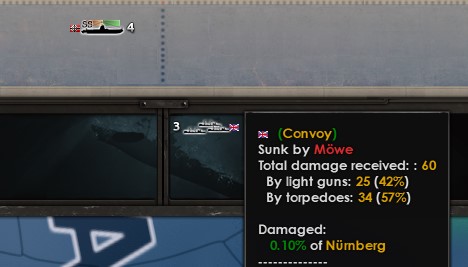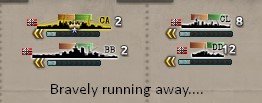Hi everyone! Since forums were all down yesterday the diary is coming today instead  Today we are going to look at core changes to naval combat coming in 1.6 Ironclad. We have already discussed how missions are changed as well as basics of the new spotting system in a previous diary and a future one will be fully dedicated to submarines so I will only cover them a little for how the interact with regular fleet battles today. So lets charge in!
Today we are going to look at core changes to naval combat coming in 1.6 Ironclad. We have already discussed how missions are changed as well as basics of the new spotting system in a previous diary and a future one will be fully dedicated to submarines so I will only cover them a little for how the interact with regular fleet battles today. So lets charge in!
Its best to start by looking at problems in the old system so you can see how we have tried to solve them and iterate. We identified the following:

To deal with distance and screening issues we have split up the battle in 4 areas per side to represent position and distances.
Screens - Your screen ships go here. Screens are the closest to the enemy and protect the ships behind them (details below).
Battle line - This is where your big guns sit. Heavy cruisers, Battleships etc. Anything with heavy long range guns. These guys also help to protect carriers and convoys behind them.
Carriers - Furthest back are carriers protected by the other two lines. This is also where convoys will be if part of the combat (say during invasion or a convoy raid battle).
Submarines - Under the sea. This area is actually two as we separate located submarines (which can be engaged with depth charges) from unlocated submarines.
By splitting things up in discrete distances unlike the old system we can more easily capture the impact of distance and positioning, and keep it easier to see what is going on at a glance.
The area they are assigned to depends on the weapons they have, which makes things tie in neatly with the ship designer. Rules for combat are now largely depend on how different weapons interact with the areas, so it is important to go over them before we continue. We also show these summarized at the top of the combat screen for quick information and to help you evaluate the combat situation:

Light Guns - These are smaller caliber guns. The armament on destroyers/light cruisers and secondary armament on heavier ships. Their job is to hit and kill smaller fast moving ships. They generally do not have the armor piercing to lay down serious hurt on capital ships. Light guns attack ships one line over. So screen ships can shoot other screen ships, and when there are no more shoot the enemies capital ships. Capital ships with secondaries can fire from behind the safety of the screens at the enemy screen.
Heavy Guns - These are hard hitting armor piercing guns designed to take out big ships. They have trouble hitting small fast ships, but when they do it is for significant damage. Heavy guns have the range to fire over one of the enemy lines. So they will be hitting the enemy battle line even if it is screened.
Torpedoes - These are the big capital killers. They ignore armor, and have big damage but are terrible at hitting fast/small ships. Torpedoes can hit any line as long as it is not screened properly. So if your screening is down to 50% then half of the enemy torpedoes can be fired at your battle line, and if the battle line is also weak some torpedoes can slip through and hit carriers or convoys.
Anti-air - AA works a bit different. When firing back at enemy planes a ship will also get a part of the fleet’s AA armament to help it, so it’s quite nice to make sure your support ships (or battleships if you focus on carriers) are stacked with as much AA as possible.
Depth Charges - This is the only weapon that can hurt subs, and it only works versus revealed subs.
Carrier Planes - Carriers can carry different kind of planes. Naval and dive bombers help attack other ships and fighters help protect yourself. The whole air model in naval combats is now more in line with the rest of the game and takes place in the airzone as you would expect. So can now be disrupted etc. This fixed a bunch of issues we had with the interaction between land based air and carriers.

Next to the weapon summaries we also display the side’s positioning value. This is a value simulating how well positioned your task forces are. A low positioning could for example mean that all your screens are scattered in a storm and your capital ships are wide open to attack. Positioning affects screening directly and a low value will directly hurt the fighting abilities of the ships as they wont be in optimal range, have another ship fouling the range etc. A big effect on positioning is the relative sizes of the fleets. So the bigger fleet will have an inherent penalty to its positioning versus a smaller, more easily controlled force. An admiral’s maneuver skill helps with this though. There are also traits like Lone Wolf and the Capital Ship Raiders tech from the Trade Interdiction doctrines that help increase this penalty for the enemy. The idea is to make smaller capital raiding forces more competitive if you tech right and have a trained Admiral in charge.

Tooltips for ships now give great breakdown on where the damage is coming from so you can see how well (or not) a particular weapon type is doing, there are also totals summarized in the top of the interface.

Entering and exiting combat
After the initial battle starts, further task forces can join. When they do they get put in the “Incoming” box, much like before. The time spent there depends on their org levels. The lower the longer they have to wait to join. Org is affected by moving, but also by giving manual orders to fleets (we want you to plan ahead, not react for max efficiency). Whenever ships are called to a combat, they will take an organization hit, which slows down their joining. Similar delays also apply for missions like convoy raiding or escort at suboptimal efficiency so it’s harder to bring all your power to bear at the same time.
On the flip side, if you take out the enemy side before the incoming ships arrive, the battle ends and you can run away (or the sides have to re-spot each other if they still want to fight), the idea is to help subs and other raiders out by allowing fast hit-and-run battles.

As for exiting combat that is both something you can order directly and something that happens when ships take enough damage (remember, you set up aggression levels to control how risky you want your task forces to be). Retreating is a process that takes some time. It is affected by doctrines, traits, weather, terrain, and the speed of the ship. We show it as a progress bar so you can bite your nails as the enemy pride of the fleet slowly gets away. Note that we also now have critical hits which will slow down ships and making it harder to run - a ship with a jammed rudder has a wooping 90% penalty to escaping. Escaping is an important part in keeping battles from being too decisive.
This is also where submarines come in. They follow normal torpedo rules, but also free to circumvent them when it comes to escaping ships. So if you have subs hiding in your battle they can engage the enemy capitals as they start to run (of course this reveals them, depending on doctrine levels, leaving them open to return fire from anti-sub vessels).
See you next week for a look at submarines

Its best to start by looking at problems in the old system so you can see how we have tried to solve them and iterate. We identified the following:
- Battles are extremely decisive so tiny mistakes have bad consequences
- Combats tend to snowballs as everyone and their mother’s fleet pile in
- A big fleet was always better, together with the above point promoting doomstacking
- The interface gets very confusing as ships close with each other. Distance overall is very hard to show and balance.
- It is easy to miss a combat happening while busy elsewhere.
- Its “simulation nature” made balancing an incredibly hard problem. Resulting in things like the all-battleship fleets performing well.

To deal with distance and screening issues we have split up the battle in 4 areas per side to represent position and distances.
Screens - Your screen ships go here. Screens are the closest to the enemy and protect the ships behind them (details below).
Battle line - This is where your big guns sit. Heavy cruisers, Battleships etc. Anything with heavy long range guns. These guys also help to protect carriers and convoys behind them.
Carriers - Furthest back are carriers protected by the other two lines. This is also where convoys will be if part of the combat (say during invasion or a convoy raid battle).
Submarines - Under the sea. This area is actually two as we separate located submarines (which can be engaged with depth charges) from unlocated submarines.
By splitting things up in discrete distances unlike the old system we can more easily capture the impact of distance and positioning, and keep it easier to see what is going on at a glance.
The area they are assigned to depends on the weapons they have, which makes things tie in neatly with the ship designer. Rules for combat are now largely depend on how different weapons interact with the areas, so it is important to go over them before we continue. We also show these summarized at the top of the combat screen for quick information and to help you evaluate the combat situation:

Light Guns - These are smaller caliber guns. The armament on destroyers/light cruisers and secondary armament on heavier ships. Their job is to hit and kill smaller fast moving ships. They generally do not have the armor piercing to lay down serious hurt on capital ships. Light guns attack ships one line over. So screen ships can shoot other screen ships, and when there are no more shoot the enemies capital ships. Capital ships with secondaries can fire from behind the safety of the screens at the enemy screen.
Heavy Guns - These are hard hitting armor piercing guns designed to take out big ships. They have trouble hitting small fast ships, but when they do it is for significant damage. Heavy guns have the range to fire over one of the enemy lines. So they will be hitting the enemy battle line even if it is screened.
Torpedoes - These are the big capital killers. They ignore armor, and have big damage but are terrible at hitting fast/small ships. Torpedoes can hit any line as long as it is not screened properly. So if your screening is down to 50% then half of the enemy torpedoes can be fired at your battle line, and if the battle line is also weak some torpedoes can slip through and hit carriers or convoys.
Anti-air - AA works a bit different. When firing back at enemy planes a ship will also get a part of the fleet’s AA armament to help it, so it’s quite nice to make sure your support ships (or battleships if you focus on carriers) are stacked with as much AA as possible.
Depth Charges - This is the only weapon that can hurt subs, and it only works versus revealed subs.
Carrier Planes - Carriers can carry different kind of planes. Naval and dive bombers help attack other ships and fighters help protect yourself. The whole air model in naval combats is now more in line with the rest of the game and takes place in the airzone as you would expect. So can now be disrupted etc. This fixed a bunch of issues we had with the interaction between land based air and carriers.

Next to the weapon summaries we also display the side’s positioning value. This is a value simulating how well positioned your task forces are. A low positioning could for example mean that all your screens are scattered in a storm and your capital ships are wide open to attack. Positioning affects screening directly and a low value will directly hurt the fighting abilities of the ships as they wont be in optimal range, have another ship fouling the range etc. A big effect on positioning is the relative sizes of the fleets. So the bigger fleet will have an inherent penalty to its positioning versus a smaller, more easily controlled force. An admiral’s maneuver skill helps with this though. There are also traits like Lone Wolf and the Capital Ship Raiders tech from the Trade Interdiction doctrines that help increase this penalty for the enemy. The idea is to make smaller capital raiding forces more competitive if you tech right and have a trained Admiral in charge.

Tooltips for ships now give great breakdown on where the damage is coming from so you can see how well (or not) a particular weapon type is doing, there are also totals summarized in the top of the interface.

Entering and exiting combat
After the initial battle starts, further task forces can join. When they do they get put in the “Incoming” box, much like before. The time spent there depends on their org levels. The lower the longer they have to wait to join. Org is affected by moving, but also by giving manual orders to fleets (we want you to plan ahead, not react for max efficiency). Whenever ships are called to a combat, they will take an organization hit, which slows down their joining. Similar delays also apply for missions like convoy raiding or escort at suboptimal efficiency so it’s harder to bring all your power to bear at the same time.
On the flip side, if you take out the enemy side before the incoming ships arrive, the battle ends and you can run away (or the sides have to re-spot each other if they still want to fight), the idea is to help subs and other raiders out by allowing fast hit-and-run battles.

As for exiting combat that is both something you can order directly and something that happens when ships take enough damage (remember, you set up aggression levels to control how risky you want your task forces to be). Retreating is a process that takes some time. It is affected by doctrines, traits, weather, terrain, and the speed of the ship. We show it as a progress bar so you can bite your nails as the enemy pride of the fleet slowly gets away. Note that we also now have critical hits which will slow down ships and making it harder to run - a ship with a jammed rudder has a wooping 90% penalty to escaping. Escaping is an important part in keeping battles from being too decisive.
This is also where submarines come in. They follow normal torpedo rules, but also free to circumvent them when it comes to escaping ships. So if you have subs hiding in your battle they can engage the enemy capitals as they start to run (of course this reveals them, depending on doctrine levels, leaving them open to return fire from anti-sub vessels).
See you next week for a look at submarines

Rejected Titles:
- Sinking inside the box for a change
- Bravely retreating in the face of underwhelming odds
- Man, those guns!
- "Stop writing dumb titles and post already podcat!"
- Sinking inside the box for a change
- Bravely retreating in the face of underwhelming odds
- Man, those guns!
- "Stop writing dumb titles and post already podcat!"





